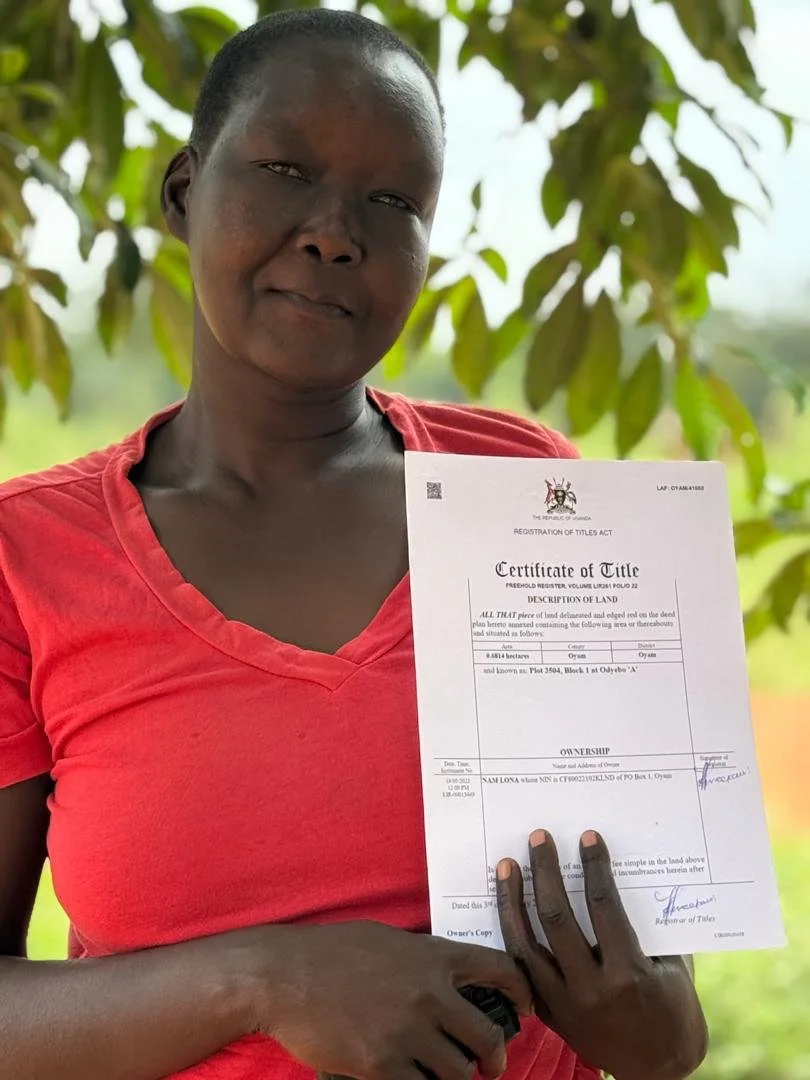
Oyam District, Uganda
In April 2025, LandBridge entered into a pilot project grant with Associates Research Trust Uganda (ARTU) to help identify and give direct aid to at least 30 women who’ve gone through the process registering their land and need assistance to pay the final fee.
Upon successful completion of the pilot, in September 2025, LandBridge and ARTU partnered to reach another 100 women by end of year.
Women’s Land Rights in Uganda
-
“Uganda boasts a relatively progressive legal framework designed to promote gender equality and protect women's rights, including those related to land ownership. Laws have been enacted and revised to address inequalities, yet the practical implementation of these laws remains problematic. Only 16% of land in Uganda is registered in the names of women, underscoring the gap between legal provisions and reality. This discrepancy is largely driven by deeply entrenched social and gender norms, which continue to favor men as the primary landowners and decision-makers in most communities.
https://www.landnet.ug/influencing-increase-documentation-land-rights-women
The Uganda Constitution (Article 237) recognises four land tenure systems — freehold, mailo, lease- hold and customary tenure — under which someone can register and own land. Freehold tenure is registered through the issuance of a certificate of title to the land owner. It is owned in perpetuity.
-
Land Titling Process in Oyam District, Uganda
Background
The Systematic Land Adjudication and Certification (SLAAC) process in Oyam district has been completed in Aber sub-county, with the first batch of land titles delivered in December 2023. However, many titles remain uncollected, particularly in Adyegi parish, due to lack of awareness and the perceived lack of immediate benefits.
Key Stakeholders
Implementing land titling initiatives requires coordination with multiple authorities:
District-level officials (CAO, Planning Officer, RDC, Police Commander, Finance Officer, LC V)
Sub-county officials (Senior Assistant Secretary, Community Development Officer)
Parish-level authorities (Parish Chief, LC I Chairpersons)
Collection Process
Selection of Beneficiaries:
Identification of female title holders through name analysis
Assessment of vulnerability based on age (using National ID numbers)
District-Level Payment (20,000 UGX):
Senior Land Management Officer submits written requests
Payment Registration Numbers (PRNs) generated electronically
Payment made via bank deposit or mobile money
System generates individual receipts
Ministry Zonal Office Payment (65,000 UGX):
Titles are submitted to the MZO after district payment
Intake Officer generates PRNs and prints invoices
Records Officer retrieves corresponding files
Payment processed through bank or mobile money
Titles scanned through the system
Registrar discharges the encumbrance on the titles
Title Delivery to Beneficiaries:
Direct delivery to beneficiaries in their communities
Documentation through interviews, photos, and videos
Challenges
System and network failures during PRN generation
First-come, first-served processing delays
Difficulty handling bulk projects alongside regular work
Limited community awareness about the importance of land titles
Geographical barriers to title collection
Impact
Land titling has helped resolve boundary disputes, encouraged some men to include their wives' names on titles, and provides a foundation for future financial inclusion and security for women.
-
LandBridge has partnered with Associates Research Trust Uganda (ARTU) to conduct its first pilot project in Uganda.
Associates Research Trust Uganda (ARTU) was set up in 2003 to undertake action, scholarly and evaluative research on contemporary questions of policy and practice relating to land tenure, natural resource use and management, agriculture and livelihoods. Since then, Associates has developed unparalleled reputation as an independent research and knowledge creation center in Uganda. In 2010, it was acknowledged as the leading research institution supporting the development of policy over land and natural resources in Uganda by the Ministry of Lands, Housing and Urban Development.




